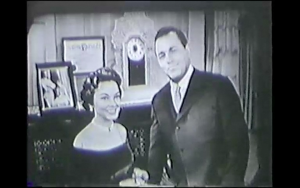Liking Ike: Eisenhower, Advertising, and the Rise of Celebrity Politics examines the prominent role that celebrities and advertising agencies played in Dwight Eisenhower’s presidency. Guided by Madison Avenue executives and television pioneers, Eisenhower cultivated famous supporters as a way of building the kind of broad-based support that had eluded Republicans for twenty years.
It is customary to see the charismatic John F. Kennedy and his Rat Pack entourage as the beginning of presidential glamour in the United States, but from Kate Smith and Irving Berlin to Jimmy Stewart, Nat King Cole, and Helen Hayes, celebrities regularly appeared in Eisenhower’s campaigns. Ike’s political career was so saturated with celebrity that opponents from the right and left accused him of being a “glamour” candidate.

An ardent golfer,
President Eisenhower posed
with a young Arnold Palmer
in 1960 at Augusta National Golf Club.
Based on original interviews and long-neglected archival materials, Liking Ike explores the changing dynamics of celebrity politics as Americans adjusted to the television age. By the mid-1920s, entertainers were routinely drawing publicity to their favorite candidates. But with the rise of television and mass advertising, political advisers began to professionalize the attention Hollywood, Broadway, and athletic stars could bring to presidential campaigns. In meetings, memos, and television scripts, they charted a strategy for “leavening” political programming with celebrity interviews, musical performances, and elaborate “television spectaculars” that would surround their candidates with beautiful sets and popular personalities. Ike’s legacy would inform the subsequent careers of John F. Kennedy and Ronald Reagan.
People were talking about Eisenhower as a presidential candidate long before his 1952 campaign. In 1950, songwriter Irving Berlin included a song “They Like Ike” in Call Me Madam, a Broadway musical starring Ethel Merman as a Washington socialite who becomes ambassador to the fictional country Lichtenburg. The musical went on to win four Tony Awards (including one for Berlin for Best Original Score.) “They Like Ike” not only promoted the possibility of an Eisenhower candidacy, but it helped coin the most effective political slogan in the history of the United States.
Help from the entertainment industry would continue through the Eisenhower campaigns. In 1952, Roy Disney, Walt’s business savvy brother, collaborated with advertising executives on a television commercial promoting General Eisenhower for president.
By 1956, scores of celebrities had joined the Eisenhower campaign, performing at rallies, speaking at press conferences, and appearing on television. Singers Kathryn Grayson and Howard Keel performed a series of Eisenhower favorites on a program celebrating President Eisenhower’s 66th birthday on CBS.  Broadcast only weeks before the November election, the program promoted a vision of the president as a genial patriarch whose likability put him above partisan politics. In this screen grab (courtesy of Rutgers University Libraries and Albert King) , Grayson and Keel sing “Down Among the Sheltering Palms” in a replica of the Eisenhower family living room in Abilene, Kansas. (The photograph behind them is of a young Dwight and Mamie.)
Broadcast only weeks before the November election, the program promoted a vision of the president as a genial patriarch whose likability put him above partisan politics. In this screen grab (courtesy of Rutgers University Libraries and Albert King) , Grayson and Keel sing “Down Among the Sheltering Palms” in a replica of the Eisenhower family living room in Abilene, Kansas. (The photograph behind them is of a young Dwight and Mamie.)
While Eisenhower enjoyed a considerable advantage when it came to attracting stars, his Democratic opponent, Adlai Stevenson, drew his own set of celebrity endorsements. Organized by Hollywood activists (rather than the Madison Avenue executives who ran Ike’s star campaigns), the commercials supporting Stevenson were often lighthearted, partisan skits that directly invoked political issues of the day. But Stevenson had a strangely erotic appeal to Hollywood women that shaped their activities. In the below commercial, for example, a member of the Hollywood Democratic Club touts her passion for the Democratic candidate.
If the Republicans liked Ike, the Democrats claimed that they loved Adlai, madly. Can you imagine a commercial such as this one today?
